The Instruction Set Architecture
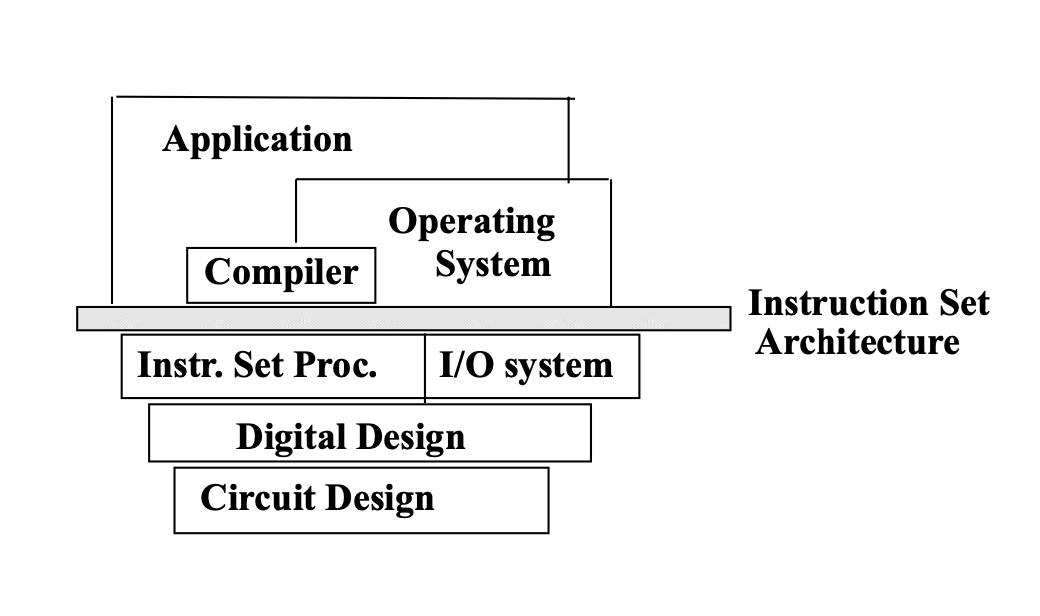
Crafting an ISA
- ISA design involves dealing in an extremely rare resource
- instruction bits! (size of instruction representation)
- Some things we want out of our ISA
- completeness
- are you able to specify everything you want to do
- orthogonality
- are you able to separate responsibilities and have them work together
- regularity and simplicity
- consistency
- compactness
- ease of programming
- ease of implementation
- completeness
Key ISA Decisions
- Operations
- how many?
- which ones
- operands
- how many?
- location
- types
- how to specify?
- instruction format
- size
- how many formats?
What enables performance in today’s machines
- Parallelism!!
- superscalar
- multiple instructions running at once
- pipelining
- instructions split into stages by HW and ran parallel based on HW
- multicore
- multithreading
- superscalar
Choice 1: Operand Location
- Accumulator
- Stack
- Registers
- Memory
- We can classify (historically) most machines into 4 types:
- accumulator
- machine with one register
- stack
- register-memory (most general)
- load-store (arithmetic operations must have register operands)! → RISC architecture
- accumulator
Choice 1B: How Many Explicit Operands?
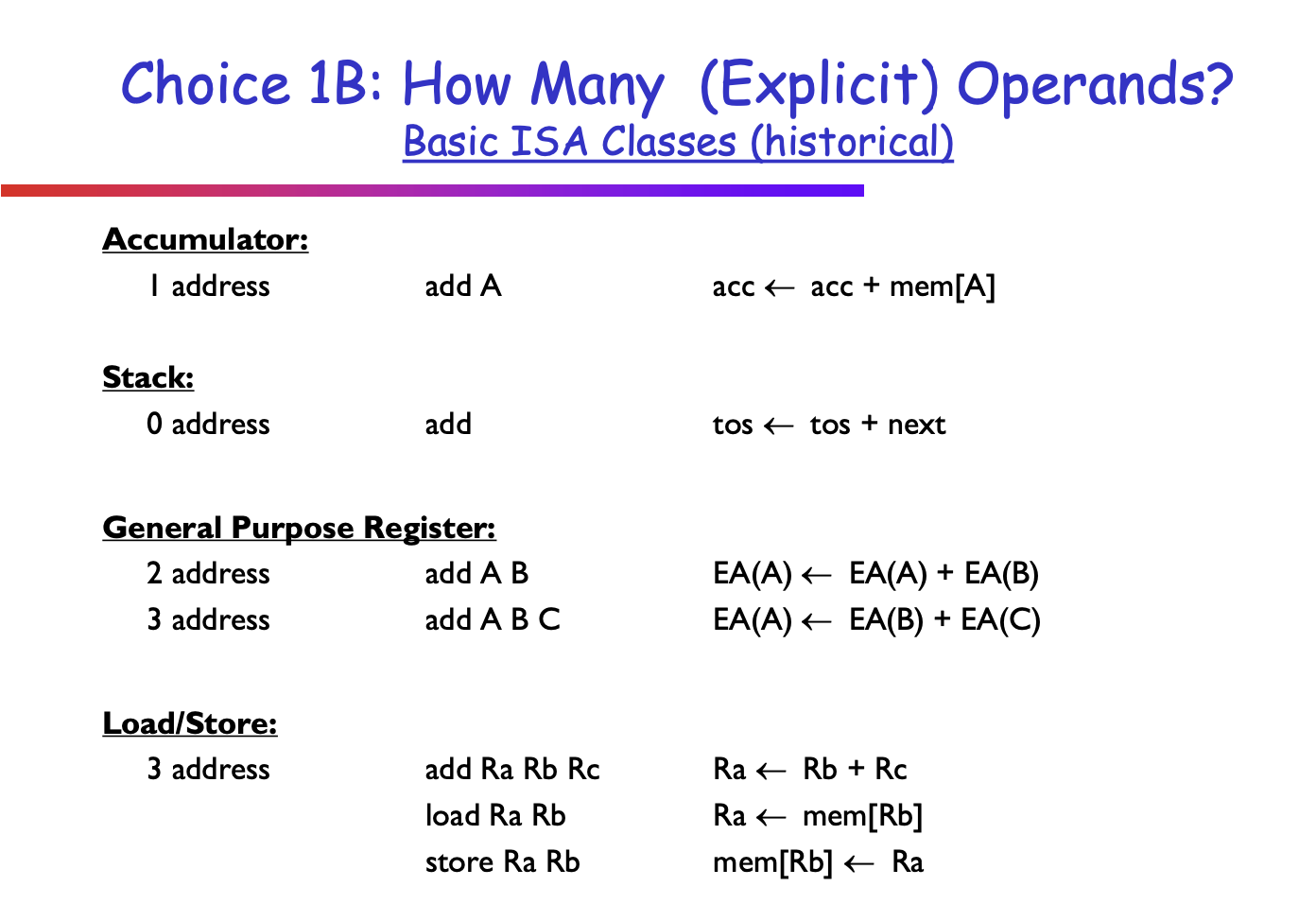 Load/store can’t do both add and load in single instruction
Load/store can’t do both add and load in single instruction
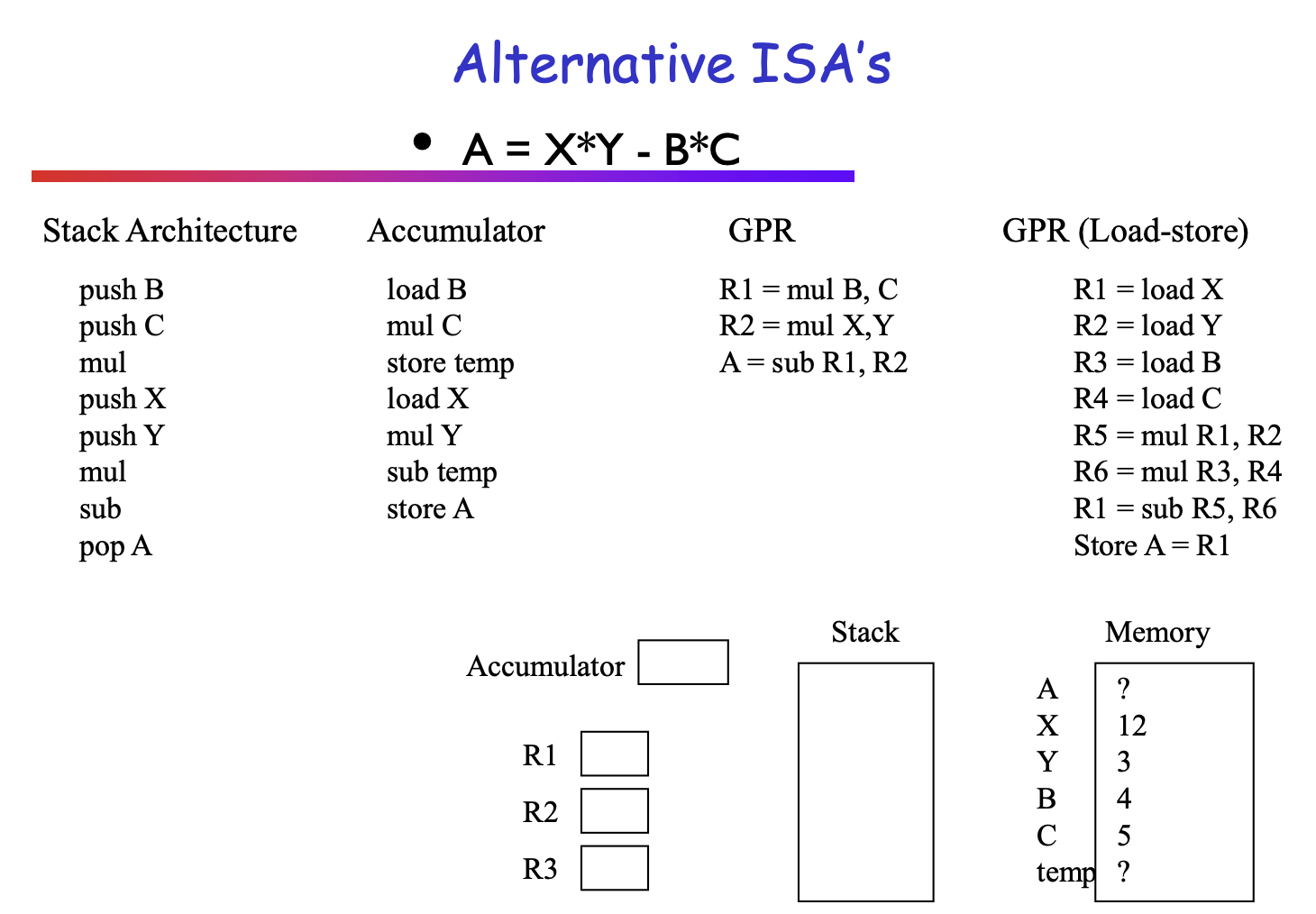 Load/store → need to get everything out of memory before using
Load/store → need to get everything out of memory before using
Choice 1: Tradeoffs
- Stack
- cons: hard to do stuff in parallel because every instruction changes stack pointer
- dependent on stack pointer for every instruction, serialized
- cons: hard to do stuff in parallel because every instruction changes stack pointer
- Accumulator
- pros: small register file
- cons: hard to parallelize everything reads and writes from accumulator
- GPR
- pros: can operate on directly on memory, faster
- pros: parallelism, split on memory
- Load-store
- …
Aside: Stack ISA
- 2 recent ones: WASM, Java byte code
Choice 2: Addressing modes
How do we specify the operand we want?
Different ways to defining an operand
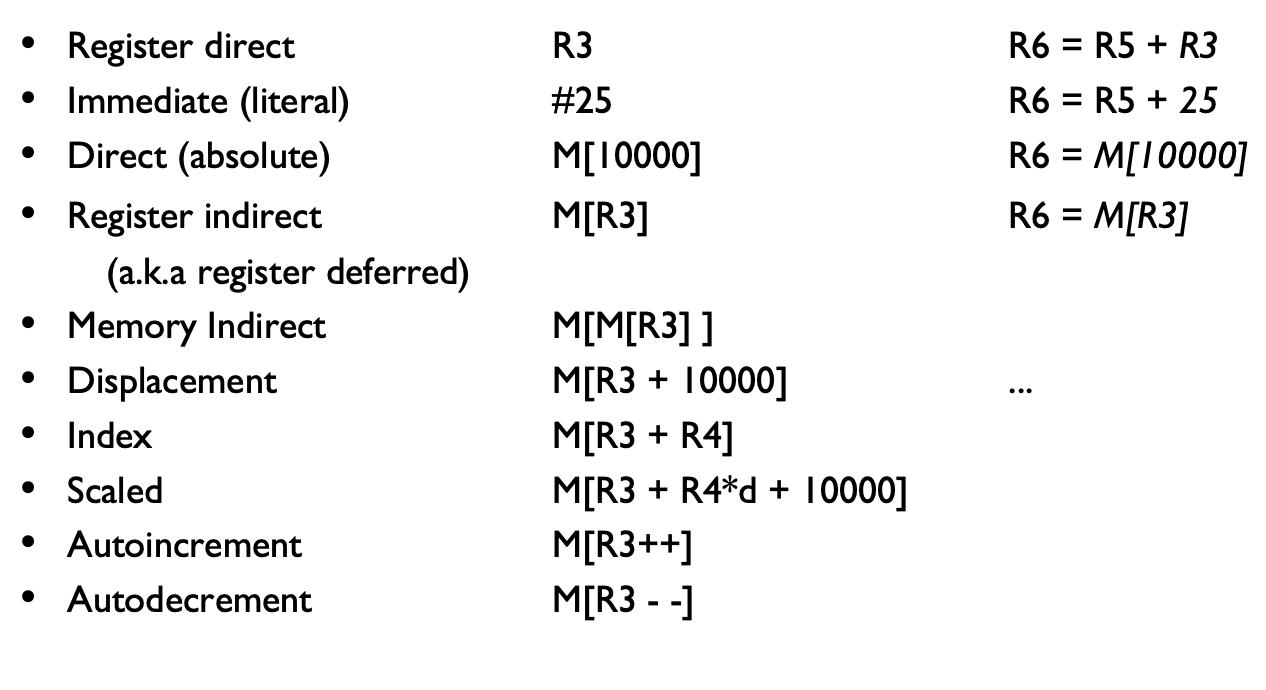
- Displacement
- good for structures (defined object/schema whatever)
- only need one pointer loaded into a register to access the whole object because we know the offset off of the structure definition
How many addressing modes are we actually using?
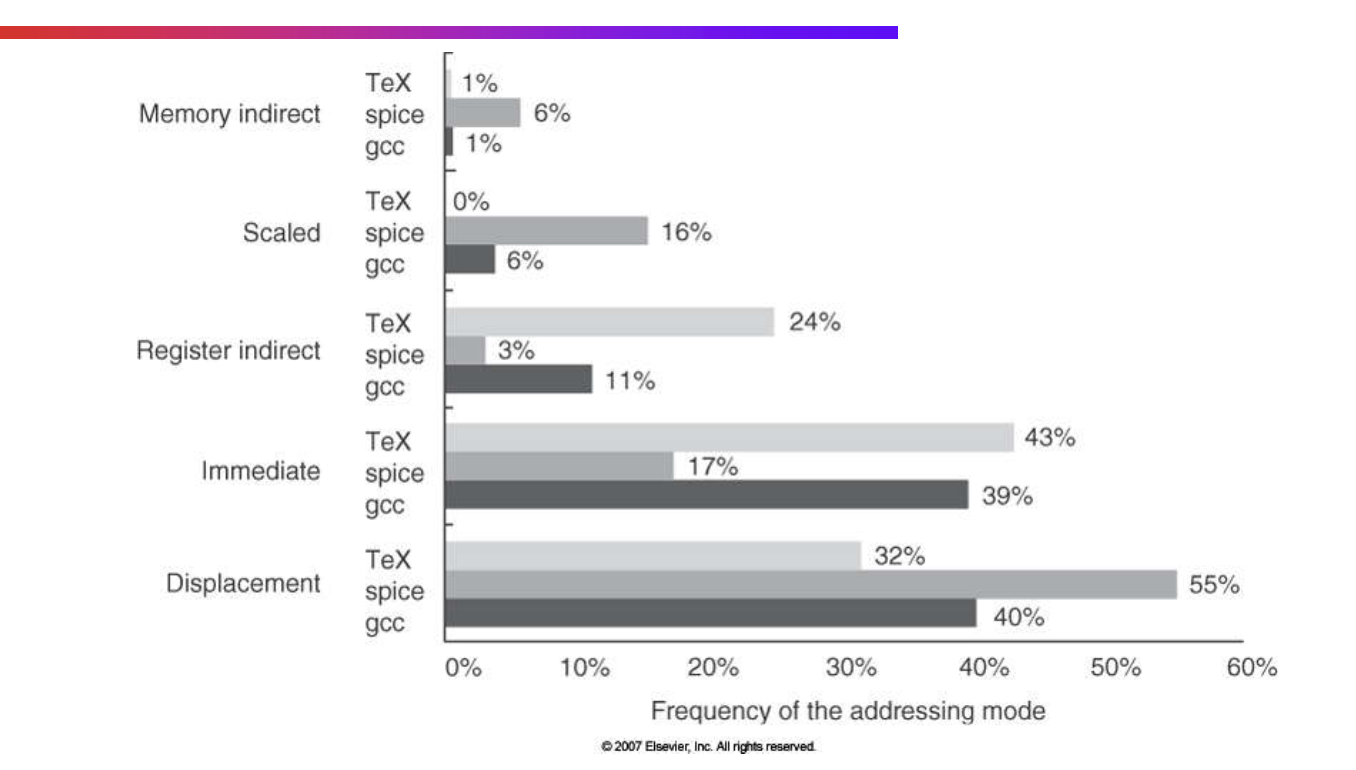
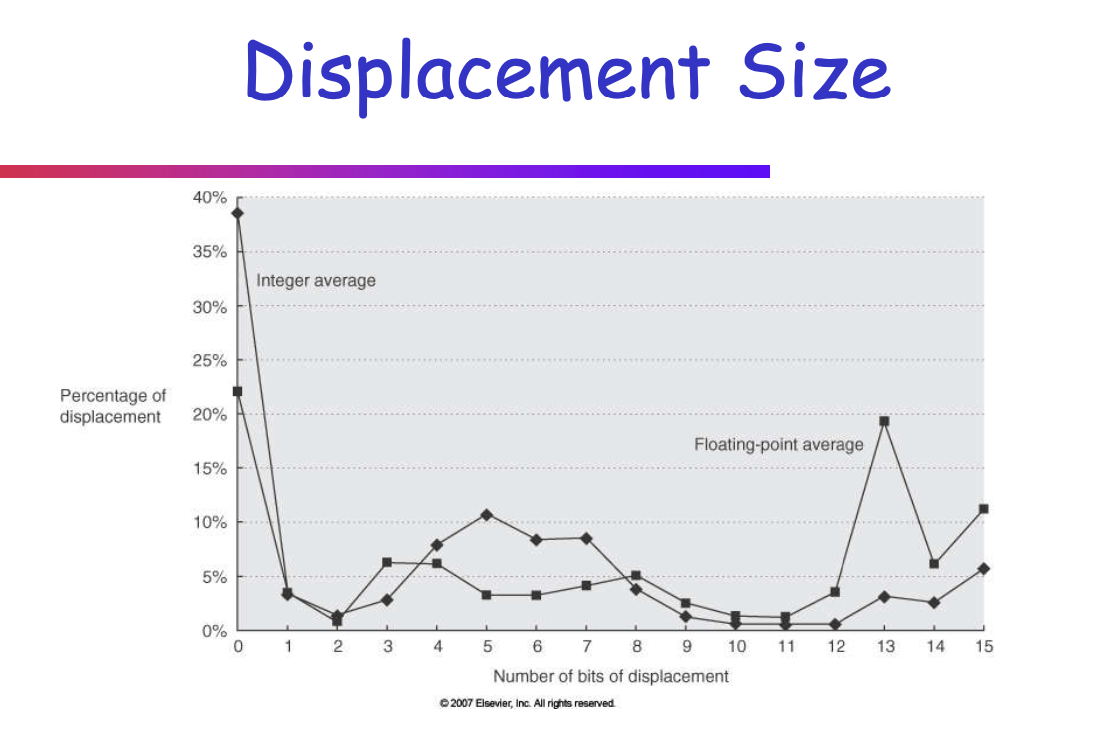 Conclusion 16 bits is usually enough. if not just use another instruction
Conclusion 16 bits is usually enough. if not just use another instruction
Choice 3: Instruction Format
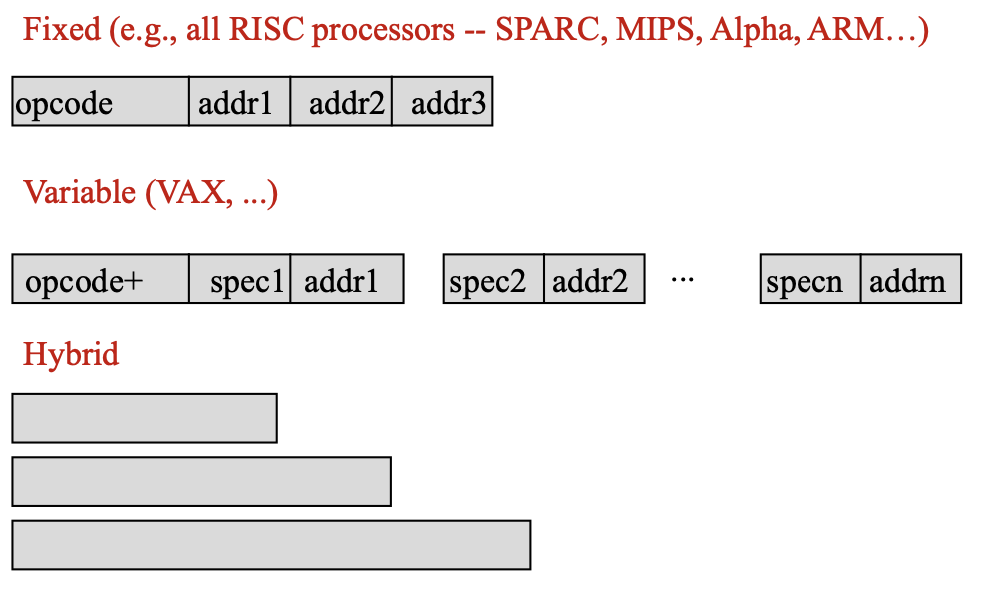
- Tradeoffs
- Variable/ hybrid: can’t decode them in parallel, no random access
Choice 4: Which Operations?
- Arithmetic
- add, subtract, multiply, divide
- logical
- and, or, shift left, shift right
- data transfer
- load word, store word
- control flow
Types of branches (control flow)
- conditional branch
- hardest to handle, later in the pipeline to figure out
- most common too
- jump
- procedure call
- procedure return
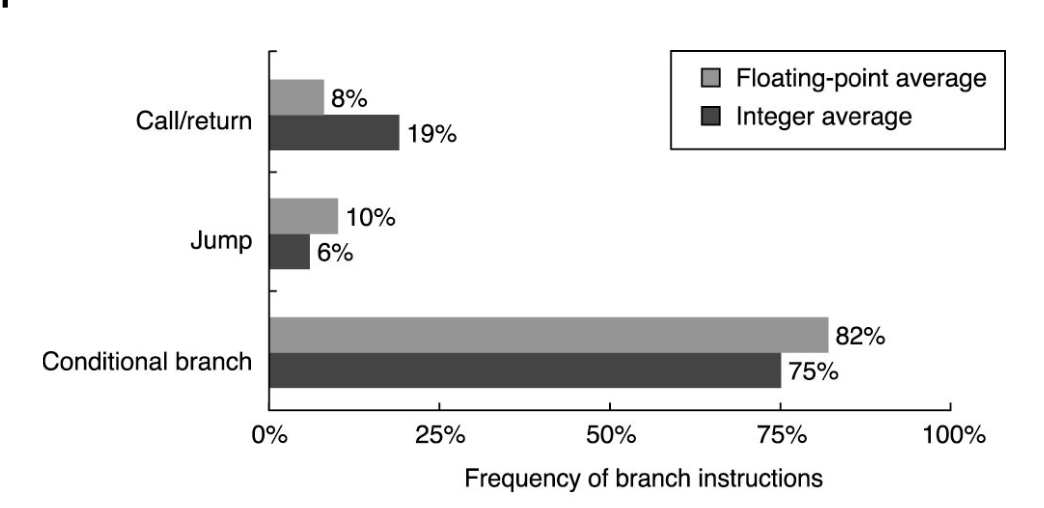
Conditional Branch
- How do you specify the destination (target) of a branch/jump?
- How do we specify the condition of the branch?
Branch Distance
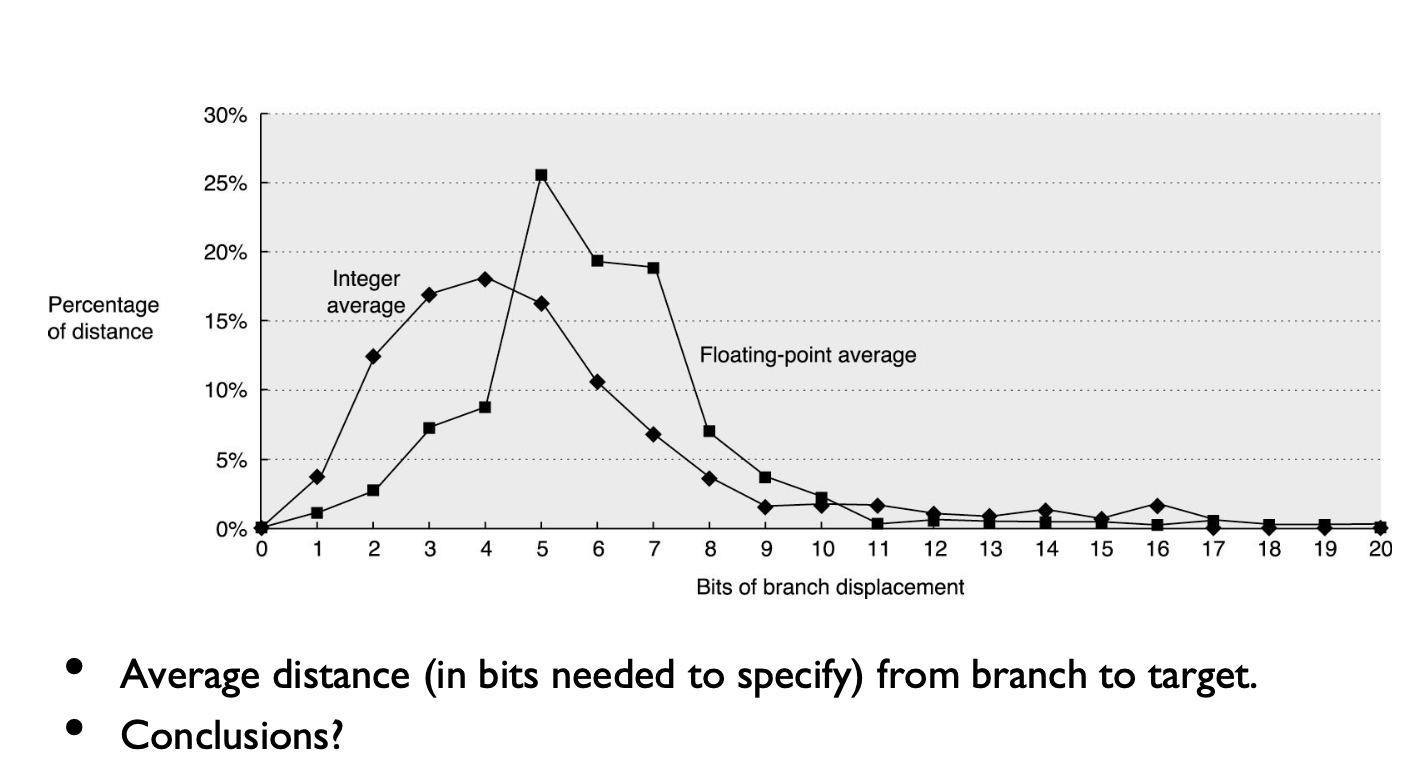 Most condition’s destination are not too far (not too many bits) so the specification is typically an offset from the src
Most condition’s destination are not too far (not too many bits) so the specification is typically an offset from the src
Branch Condition
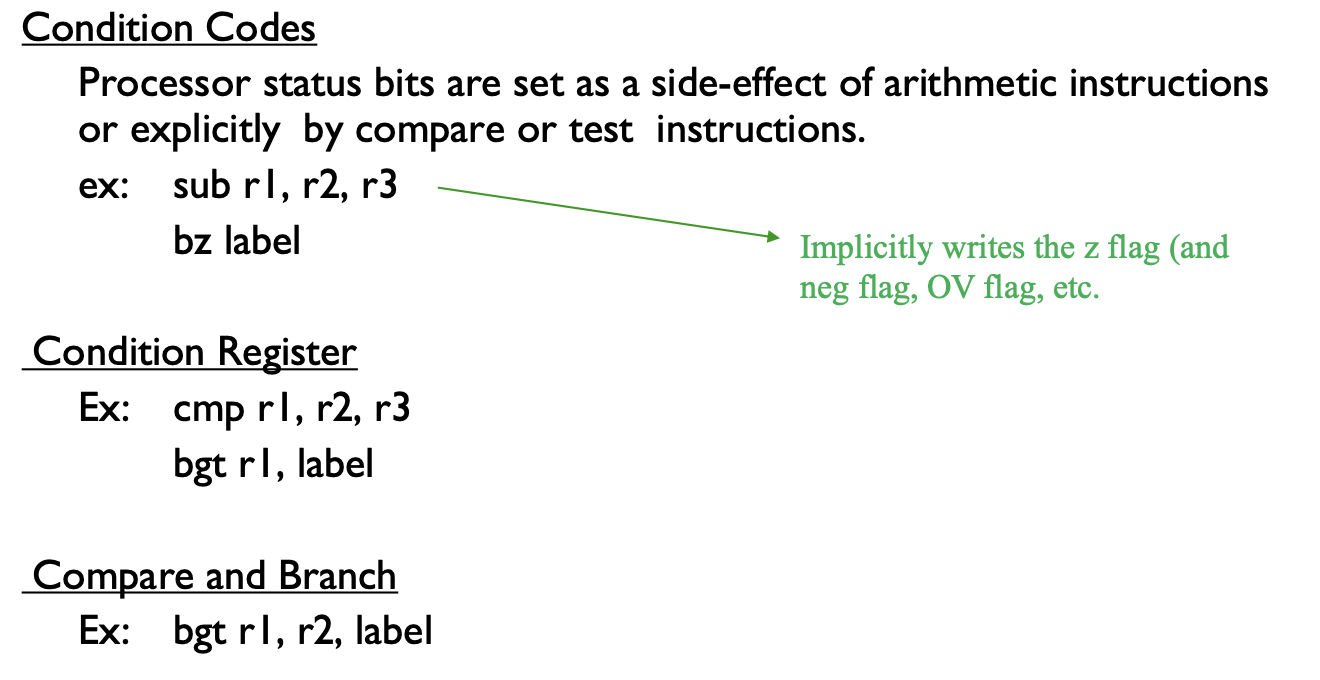 Parallelism issue - dependency on condition
Parallelism issue - dependency on condition
The Customer is Always Right
- Compiler is the primary customer of ISA
- features the compiler doesn’t use are waster
- register allocation is a huge contributor to performance
- compiler-writer’s job is made easier when ISA has
- regularity
- primitives, not solutions
- simple trade-offs
- summary →simplicity over power
Our desired ISA
- Registers, Load-store
- Addressing modes
- immediate (8-16 bits)
- displacement(12-16 bits)
- register deferred (register indirect)
- support a reasonable number of operations
- don’t use condition codes
- fixed instruction encoding/length for performance
- regularity (several general-purpose registers)
MIPS ISA
- 32 64-bit general-purpose registers
- R0 always equal zero
- 32 FP registers
- immediate and displacement addressing modes
- register deferred is a subset of displacement
- 32-bit fixed-length instruction encoding
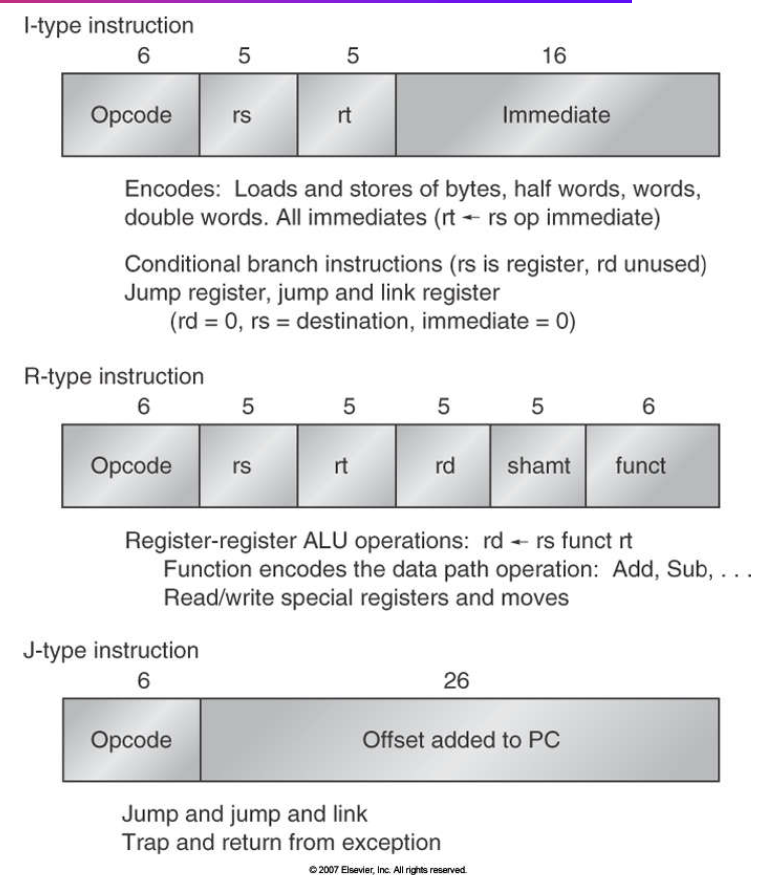
RISC-V ISA
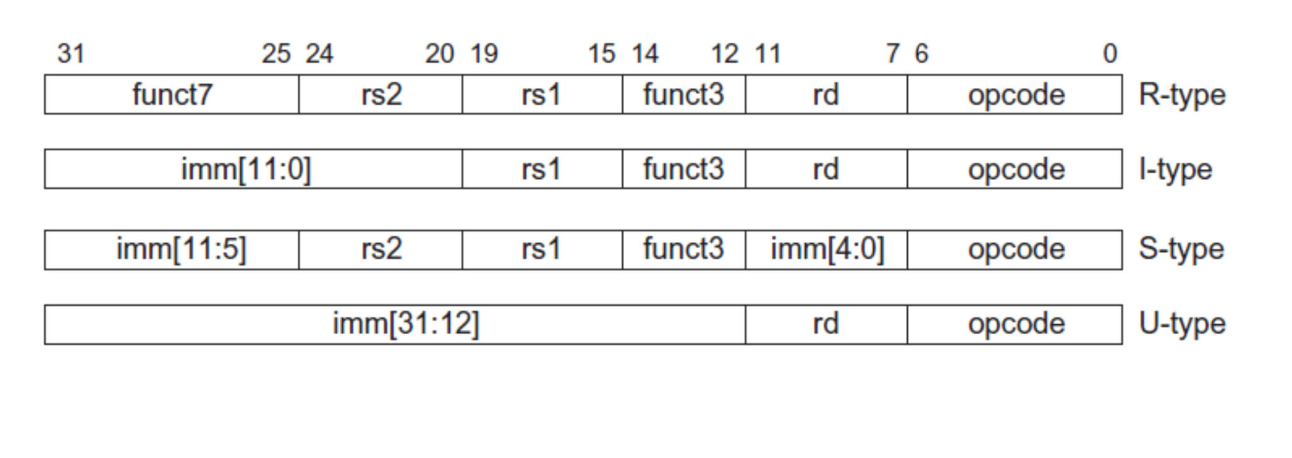
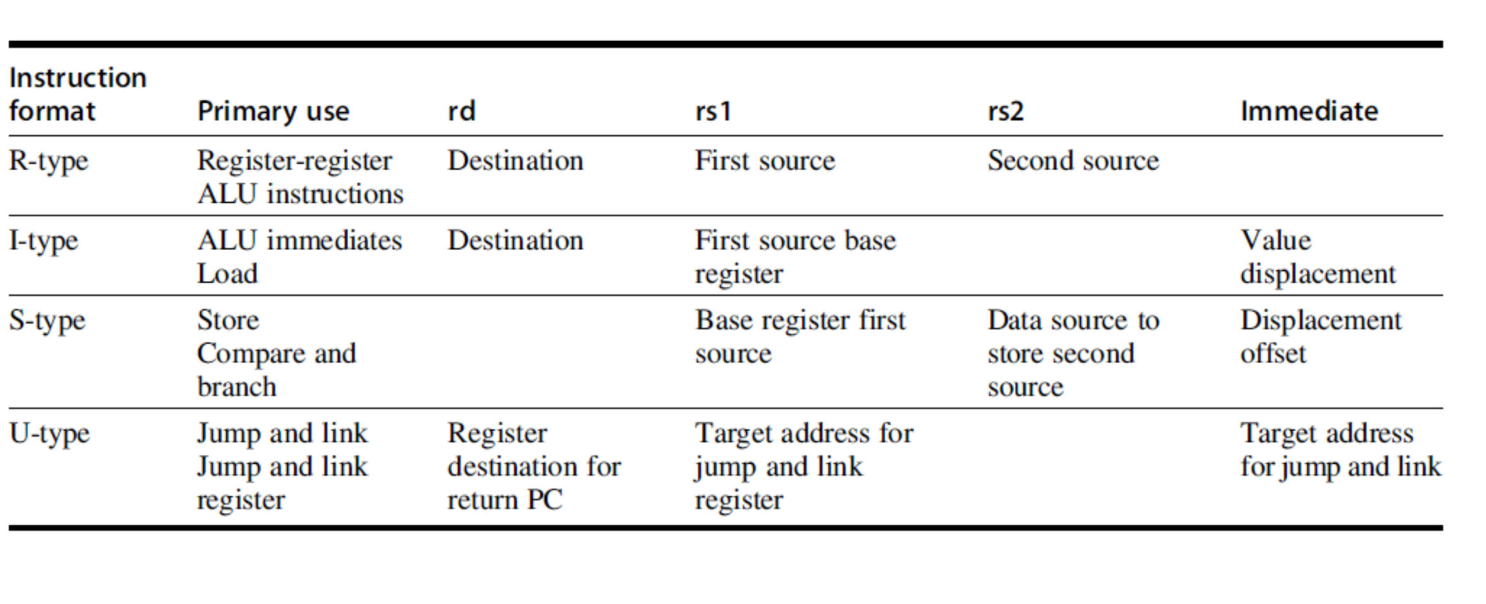
RISC-V vs MIPS
- surprisingly similar. fixed a few flaws in early RISCs
- suport for bgt, blt, etc
- no branch delay slot
- 7-bit opcodes
- one format with larger immediate
ARM vs MIPS
- ARM originally targeted at small embedded processors
- Priorities: energy efficiency, small instruction footprint
- The most visible difference between ARM and all other RISC ISAs is that nearly all instructions can be conditionally executed (predicated)
- ability to execute either path of the conditional
- although using executing both is not better than guessing
- prediction is useful for performance
- ability to execute either path of the conditional
RISC vs CISC
- MIPS and RISC-V are classic RISC architectures (as are SPARC, Alpha, PowerPC,…)
- RISC stands for Reduced Instruction Set Computer. RISC architectures are load-store, few formats, minimal instruction sets.
- They were in contrast to the 70s and 80s which proliferated CISC ISAs (VAX, Intel x86, various IBM), which were characterized by complex and comprehensive instruction sets, and complex instruction decoding.
- RISC architectures thrived not because they supported fewer operations, but because they enabled parallelism.
Intel x86
- CISC architecture (does not parallelize or pipeline well)
- variable length instruction set architecture (1 byte to 15 bytes)
- has an instruction for “find the matching words in two strings of arbitrary size”
- most instructions are two operand
- Add eax, ebx ⇒ eax = eax + ebx
- How do they compete with RISC ISAs?
- Micro-ops!
- TODO readup
MIPS
- Read on your own and get comfortable with instructions and formats
Ongoing Research
Evolution of On-chip Heterogeneity
Multiple different ISA multicore architectures
- uses best of different ISAs
Mobilizing the Micro-Ops
Exploiting Translated ISAs …
ISA Key Points
- Modern ISA’s typically sacrifice power and flexibility for regularity and simplicity; code density for parallelism and throughput.
- instruction bits are extremely limited, particularly in a fixed-length instruction format.
- Registers are critical to performance – we want lots of them, and few strings attached.
- Displacement addressing mode handles the vast majority of memory reference needs.
- There are a fair number of design choices even between similar (eg, RISC) ISAs